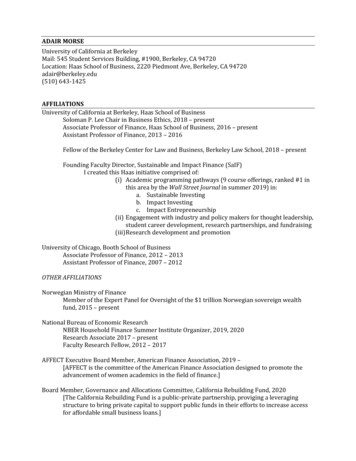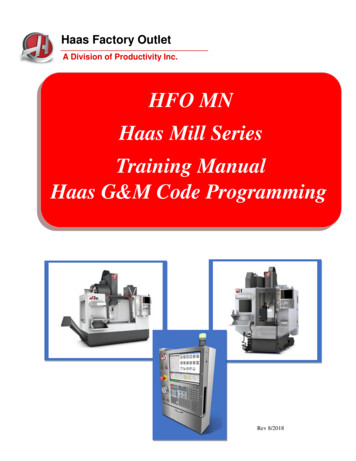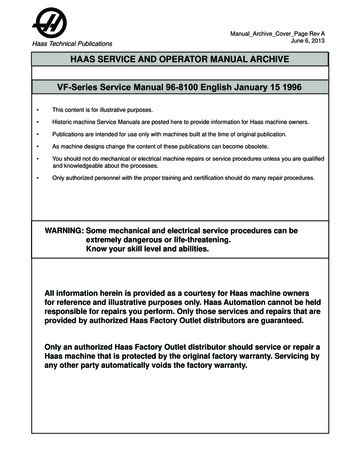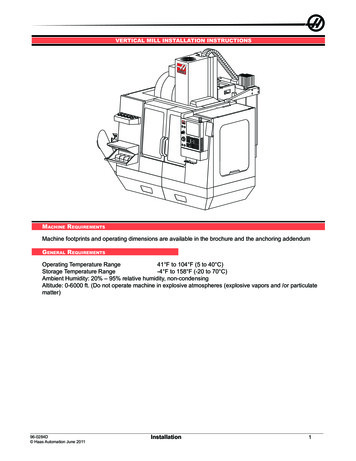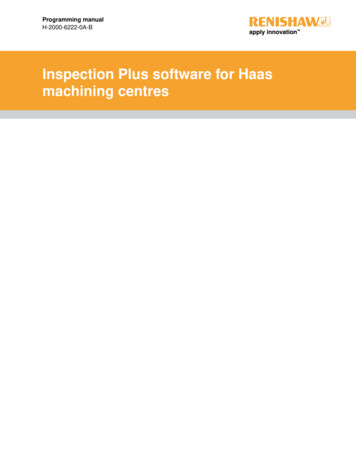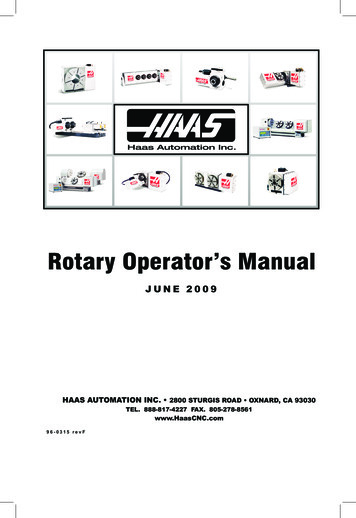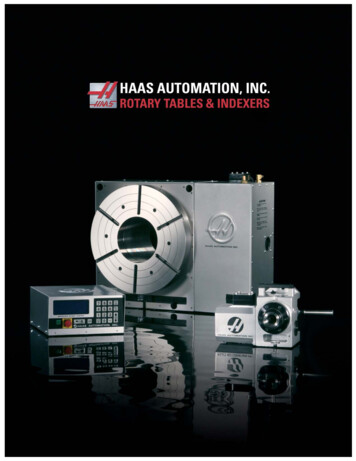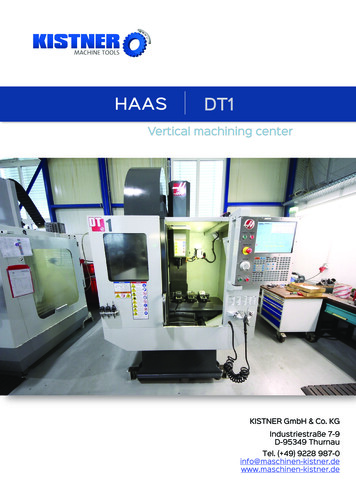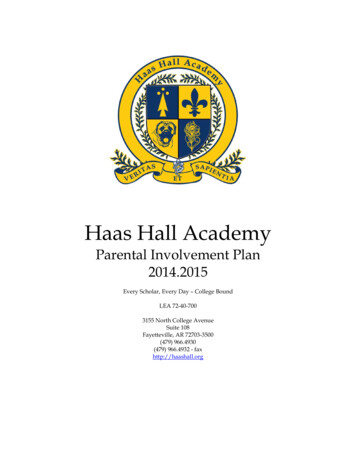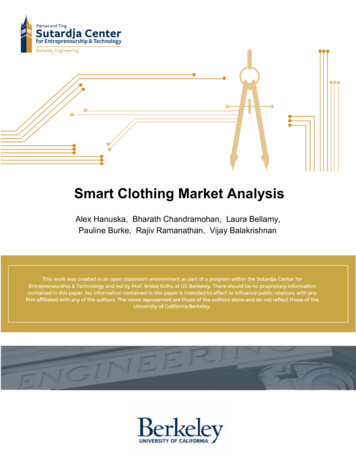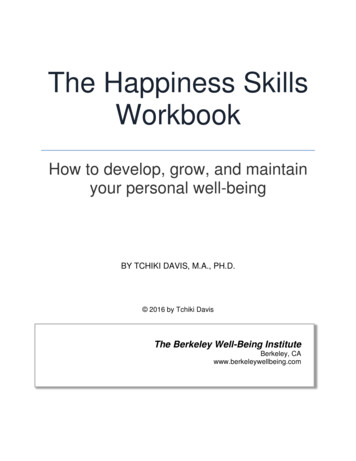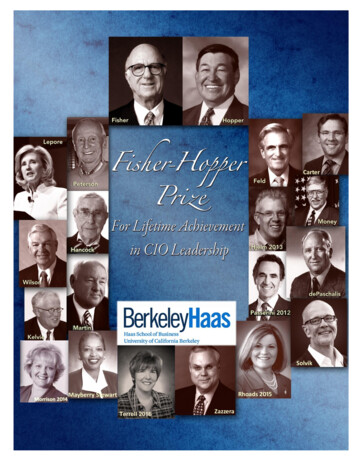
Transcription
Terrell 2016
1 Page
To the 5th annual Landmark CIO Community Event Renaissance CIO Banquet Announcement of the winner of the Fisher-Hopper Prize forLifetime Achievement in CIO LeadershipYou are a distinguished audience. We thank you for attending this very special occasion.Jim SpitzeUC, BerkeleyMichael de PaauwExecutive Programs2 Page
Table of ContentsEvent program . 4About the Speakers and Panelists . 6The Fisher-Hopper Prize . 8The Fourteen Original Recipients of the Fisher-Hopper Prize. 12The First Four Winners of the Fisher-Hopper Prize . 13This Year’s Finalists for the Fisher-Hopper Prize . 14The Members of the Candidate Selection Committee for the Fisher-Hopper Prize . 15Fisher CIO Leadership Program History and Description . 16About Gartner Executive Programs . 19Our Distinguished Sponsors . 20Cover by anonymous artist / Graphics & Lay-out – Michael de Paauw3 Page
Event program4 Page
Award BanquetMediterranean Salad - Roma tomatoes, English cucumbers,spinach & Kalamata olives, red onions, feta cheese—0—Choice of the following entrees:Chicken Salinas - chicken breast filled with artichoke hearts, goatcheese and spinach with a tarragon sauceFresh Grilled Salmon - with a tomato fennel sauceRoast Prime Rib of Beef - with gravy and creamed horseradish;Above entrees come with potatoes or rice and seasonal vegetablesPortobello Mushroom Ravioli with Ancho Chile Cream Sauce—0—Dessert - Assorted fruit pies a-la-mode5 Page
About the Speakers and PanelistsJames M. Spitze — Executive Director,Fisher CIO Leadership Program, Haas Schoolof Business. Jim has had a distinguishedcareer as IT executive, having served as CIOfor Xerox Data Systems, American PresidentLines, Tri Valley Growers, and (as a consultant) forQANTAS, Tencor instruments and several other privatesector firms. He served as the Fisher Program’s foundingExecutive Director from 1991-1996 and was invited toreturn again in 2009.Michael de Paauw — Michael is anExecutive Partner in Gartner ExecutivePrograms. He is a coach and thoughtpartner to over 20 CIOs in variousindustries. His research focus is oninnovation, emerging trends and technologies, and ITstrategy. Before joining Gartner, Michael was on theboard of several IT companies, including Pearson VUE,CompuTrain and Kender Thijssen. Earlier, he worked asthe European IT director of the Bastion Hotels chain.Dale Kutnick – Dale Kutnick is Senior VicePresident, Emeritus, and DistinguishedAnalyst. His primary responsibilities areworking with CIOs and senior businessleaders to help them better manage andexploit technology and information to drive businesstransformation and enablement. He serves on the boardof i.c. stars (Chicago), on the board of Riverkeeper(Ossining, New York), on the Clinical Advisory Board ofIpsen Pharma (Paris) and on the Technical AdvisoryBoard at Danbury Hospital. Mr. Kutnick is a graduate ofYale University (U.S.).Brad Peterson – Executive Vice Presidentand Chief Technology and ChiefInformation Officer (CTO/CIO) for Nasdaq.He previously served as CIO for SchwabTechnology Services, responsible fortechnology innovation, development, infrastructure andoperations. Peterson also served as CIO at eBay and wasthe Managing Director and COO at Epoch Securities. Heearned his master's degree in management at MIT Sloanand a bachelor's degree in systems science andeconomics at the University of California, Los Angeles(UCLA).DuWayne Peterson – DuWayne is retiredand was selected as a Renaissance CIObased on his tenure at Merrill Lynch whichincluded the stock mart crash in October1987. In the crash aftermath, his teammodernized infrastructure, installed networkedclient/server systems, consolidated data centers, andintroduced selective outsourcing – thus creating, whileothers retrenched, a next generation integratedbrokerage system.Jyoti Bansal – Founder, Executive Chairmanof the Board and Chief Strategist ofAppDynamics. Jyoti has received manyleadership awards, like: "Best CloudComputing CEO to Work For" (Forbes/2013),"Best CEO" (San Francisco Business Times/2014). Beforefounding AppDynamics in 2008, Jyoti held engineeringroles at various Silicon Valley startups. Jyoti received hisBS in Computer Science from the Indian Institute ofTechnology, Delhi and is the lead inventor on 20 USpatents.Graham Waller – Gartner Research VPVice President and Analyst in the DigitalBusiness Leadership research team. Heworks primarily with CIOs and executivelevel digital leaders with an emphasis oncontemporary leadership (i.e., fit for"digital era purpose") and realizing business advantagevia technology. Mr. Waller is a co-author of the Gartnerbooks "Digital to the Core" and "The CIO Edge"Dacher Keltner – Professor of psychology atthe University of California, Berkeley, andthe founding director of the university’sGreater Good Science Center. Keltner hasdevoted his career to studying the nature ofhuman goodness and happiness, conductingground-breaking research on compassion, awe, laughter,and love. He is the author of the books Born to Be Good,The Paradox of Power and a co-editor of theanthology The Compassionate Instinct (W.W. Norton,2010).6 Page
Sheila Jordan – chief information officer ofSymantec. Sheila joins Symantec after nineyears with Cisco, where she was responsiblefor delivering and integrating key IT servicesfor Cisco's global workforce. She brings extensiveexpertise in driving enterprise collaboration across multiplechannels including various mobile platforms. Sheila alsohas held leadership roles at The Walt Disney Company andMartin Marietta. She received her Bachelor of Arts degreein accounting from the University of Central Florida and herMaster of Business Administration degree from the FloridaInstitute of Technology.Tom Keiser – Chief Information Officer ofZenDesk. From January 2014 to March 2015, Tomserved as Executive Vice President of GlobalProduct Operations at The Gap, Inc., an apparelcompany, where he also served as Chief Information Officerfrom January 2010 to December 2013. Tom was previously atLBrands, a fashion retail company, from April 2004 toOctober 2009, where he held positions as Senior VicePresident of the INSIGHT program and as Executive VicePresident and Chief Information Officer. Tom holds a B.S. insystems science from the University of West Florida.Patty Hatter – vice president and generalmanager of the Intel Security GroupProfessional Services organization at IntelCorporation. She recently transitioned fromthe role of Intel Security CIO, and prior to thatwas the vice president of Operations and CIO at McAfee.She has overall responsibility for leading the professionalservices organization and expanding Intel Security’sconsulting, managed services, deployment, and trainingservices. Patty earned bachelor’s and master’s degrees inmechanical engineering from Carnegie Mellon University.Rebecca Rhoads –President of Global BusinessServices and CIO of Raytheon. RaytheonCompany, a technology and innovation leaderspecializing in defense, civil government andcybersecurity markets throughout the world.Raytheon is headquartered in Waltham, Mass. Rhoads wasappointed president of Raytheon’s Global Business Services(GBS) in December 2013, to facilitate expansion of commonbusiness operations across the company’s enterprise servicedelivery areas. Rhoads was awarded the Fisher Hopper CIOLifetime Achievement award in 2015.Ralph Loura – As Chief Technical Officer forRodan Fields, Ralph leads the company’stechnology strategy and execution. With morethan 30 years of experience drivinginformation technology strategies for major brands, hedefines and advances strategies for digital product,enterprise solutions and infrastructures to support oursignificant growth and deliver user-centric digitalexperiences. Previously, Ralph was Vice President and CIOfor Enterprise Group and Global Sales Ops at HP, CIO at TheClorox Company and he has held technology leadershiproles at Cisco, Symbol and AT&T Bell Laboratories. He holdsan M.S. in computer science from Northwestern Universityand a B.S. in mathematics and computer science from St.Joseph's College.Michael Leckie – Chief Learning Officer for theDigital Industrial Transformation at GE. In thisrole he is responsible to support the culturaltransformation of GE to be the DigitalIndustrial leader. He works closely with GE’s Digital andExecutive Leadership driving rapid change and personal andbusiness transformation. He also leads an effort across GEto continually raise our acumen in what it means to be trulydigital. Michael joined GE in 2016 from Gartner where hemost recently held the position of Managing Vice Presidentin Gartner’s Executive Programs business. Michael has heldconsulting roles with both Arthur Andersen and boutiquefirms and internal OD/L&D/HR roles with industry-leadingfirms. Michael earned his Masters of Science in OrganizationDevelopment from Pepperdine University in Malibu, CA7 Page
The Fisher-Hopper PrizeIt started with two telephone conversations: In the fall of 2008, my cellphone rang while I was driving South on the Nimitz Freeway. When I answered, I heard thevoice of Don Fisher, the co-founder of The Gap. I pulled off the freeway and Don and I talked for maybe ten minutes.He was concerned regarding the inactivity of the Fisher Center at Cal and wanted me to return to the position I hadfounded in the early 1990s. I agreed to do so. The process took a few months. By early 2009, I was, once again, onthe staff of UC-Berkeley as the Executive Director of the Fisher CIO Leadership Program. Sometime in March or April of 2009, our home phone rang and my wife answered it in our pantry. It was my goodfriend, Max Hopper. For several minutes, he and I discussed the sorry state of the CIO profession and speculated onwhat percentage of CIOs were really contributing to the competitive advantage of their companies. I said “2% to 4%”and Max responded by saying I was far too pessimistic; that it was assuredly something more like “3% to 5%” – towhich we both laughed.Max suggested that I use my newly acquired “bully pulpit” of the Fisher Program to raise the issue and do so by writing apaper outlining some of the major competitive advantages successes of the Top Tier CIOs. I asked him who these were andhe suggested we form a committee to develop a strong list. He went on to suggest five members: 1-himself, 2-me, 3-Bruce J.Rogow, 4-Naomi Seligmann, and 5-Harvey Koeppel. I believe Max invited Naomi and Harvey. I invited Bruce. All agreed toserve. By mid May 2009 the Top Tier list began to take shape. I have in my files a 5/15/2009 email from Bruce Rogow thatcontains five suggested names, all of which made it on to the final list.At some point I invited Judith J. Lee, Ph.D. and at the time an Adjunct Professor in IT Management at Golden Gate University,to work with me on this. We decided that, before we started inviting any of the CIOs on the list to participate, we shouldhave a well thought-out list of interview questions to give them so they could make an informed decision.The question list evolved over the summer and early Fall. By October both the fourteen person Top Tier list and the list oftwelve questions had stabilized and I started contacting the CIOs and sending them a copy of the “Twelve QuestionInterview Guide.” All except one CIO agreed to participate and that person was quickly replaced with an individual whoprobably should have been on the list in the first place.While both lists were still not quite final, we started the interviews. The following table shows the interviewee sequence:INTERVIEWEE1 – Art Money2 – Max Hopper*3 – Carl Wilson4 – Melodie Mayberry Stewart**5 – Jack Hancock*6 – Ed dePaschalis*7 – Bill Kelvie8 – Dawn Lepore9 – Rob Carter10 – Bobby Martin11 – Paul Zazzera*12 – Pete Solvik13 – Charlie Feld14 – DuWayne Peterson*deceased**incapacitated by a /02/1004/01/1005/03/10COMPANYUS Dept. of DefenseSABRE-American AirlinesMarriott InternationalCity of ClevelandChemical BankLevi StraussFannieMaeCharles SchwabFedEXWalMartTime WarnerCiscoFritoLayMerrill-Lynch8 Page
As the interviews progressed, Judy and I consolidated our notes of each interview and sent them to the interviewee for hisor her review, correction, and sometimes, expansion. At the same time, we started distilling those notes and searching forthe elusive “factors of extraordinary success” which was to become the focal point of our paper.The paper went through a large number of revisions. After one false start, it was accepted for publication by the CaliforniaManagement Review (CMR) and published in that journal’s Winter 2012 issue (vol. 54, No. 2) with the title “The RenaissanceCIO Project: The Invisible Factors of Extraordinary Success.” It has since become one of the CMR’s most frequentlydownloaded papers.The fourteen CIOs were called Renaissance CIOs in keeping with the meaning of that term as originally used by Prof. RichardNolan of the Harvard Business School when he described and analyzed the career of Pete Solvik, the then CIO of Cisco.While all of this was happening, the two individuals who made it all happen, had passed away; Don Fisher on Sunday, Sept.27, 2009, and Max Hopper on Monday, January 25, 2010.I do not recall who it was but someone, after the Renaissance CIO paper was published and quite well received, suggestedthat I should do something to insure that the findings of the paper were not forgotten. That suggestion led me to create TheFisher-Hopper Prize for Lifetime Achievement in CIO Leadership with the annual winners of that prize being added to the listof Renaissance CIOs, thus insuring the perpetual continuation of that group as its fourteen founding members eventuallypass away.As might be obvious, the prize honors Don Fisher and Max Hopper.DON FISHER (1928-2009)Don was a 1946 Graduate of Lowell High School in San Francisco and then a 1951 graduate of University of California,Berkeley (BS in Business Administration) and a member of both the Swimming and Water Polo teams. He founded The Gapwith his wife, Doris, in 1969. They went on to build it into one of the largest and most successful specialty clothing companiesin the world. One element of its success was a far advanced for its time inventory planning and stocking system. Don was apassionate believer in the value of “IT” as a competitive asset – and used it in that way at The Gap.Don and Doris were major philanthropists – most often to educational institutions and causes – with UC Berkeley and itsHaas School of Business being high on their list of recipients. He was a major contributor to KIPP charter schools and was atone time the chairman of the board of directors of the KIPP Foundation.Don and his wife were also major collectors of contemporary Western art. Their collection eventually became one of thelargest and most famous of its kind in the world. San Francisco’s Museum of Modern Art (SFMOMA) is currently beinggreatly expanded to enable the display of this remarkable collection.MAX HOPPER (1934-2010)Max was born in a log house near Lufkin, Texas. Family finances made his early education one of several interruptions beforehe graduated for the University of Houston with a degree in mathematics. In January, 1955, while a Shell employee, he joinedthe US Army’s Security Agency where he learned Morse Code and became interested in computers. When he left the army,he returned to Shell and put his interest in computers to business use, demonstrating a life-long interest in operationsresearch.From Shell, Max moved to EDS and then to United Airlines, before settling in at American Airlines in 1972. Except for a briefinterlude at Bank of America in the early 1980s, he remained at American until he retired as Chairman of its Sabre Group in1995.9 Page
While at American, Max pioneered electronic commerce for the travel industry. His SABRE system grew from serving just theneeds of American Airlines to become the world’s largest computer reservations systems – used today by airlines, railways,hotels, travel agents, and other travel companies worldwide.THE PRIZE PROCESSThe idea of a prize that would honor Don and Max was well received. The original committee that had developed the list ofthe original fourteen Renaissance CIOs agreed to continue but in a new role – as a candidate identification committee thatwould annually come up with a list of 3-4 candidates for the Renaissance CIOs plus the previous winners of the FisherHopper Prize to vote on.The committee agreed that the purpose of the prize was three-fold:1. to honor the lifetime achievements of two extraordinary individuals, Don Fisher and Max Hopper2. to annually honor a currently active CIO for his or her lifetime achievements in CIO leadership3. to ensure by the addition of the annual prize winner to the list of Renaissance CIOs, the “in perpetuity” continuance ofthe Renaissance CIO group.It is the committee’s hope, as the founders of this prize, that it become the premier prize for those who work in the ITManagement field. With that in mind, the committee decided to use the same selection criteria that was used for the originalfourteen Renaissance CIOs:The Naomi Seligman Selection Criteria - As described in the CMR article, Naomi Seligman suggested the following criteria for theselection of the Renaissance CIOs:1. Must be “wicked smart” (exact words of Naomi Seligman)2. Must have had a massive and enduring positive impact on their employer3. Must have had a massive and enduring positive impact on their industryThe Bruce J. Rogow Candidate Selection Logic - In selecting the candidates for the Fisher-Hopper Prize (to continue theRenaissance CIO group), Bruce Rogow suggested the following logic be followed in addition to continuing the use of the NaomiSeligman criteria:1.2.3.4.5.6.7.Unless a CIO has been at a firm for OVER 5 years, there can be no assurance that what they did was of lasting valueUnless a CIO has been at a firm for at least 5-7 years, it is hard for me to believe that they institutionalized theiraccomplishments and built a sustaining teamUnless a CIO has been at a firm for over 7 years, it is unlikely they have managed thru "seasons" of the business cycle(upturn, uncertainty, downturn, consolidation, innovation, major change) and management cycles.If they haven't provided leadership across changes in business seasons they may be one trick ponies who fell into aperfect fit for their skills, style and temperamentWe should hear stories about how they have impacted their firms and their industries.We should find their protégés either picking up where they left off after they leave or in other firms succeeding asCIOs.We should limit our candidates to those tha
Executive Director from 1991-1996 and was invited to return again in 2009. Michael de Paauw — Michael is an Executive Partner in Gartner Executive Programs. He is a coach and thought-partner to over 20 CIOs in various industries. His research focus is on innovation, emerging
